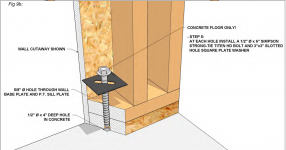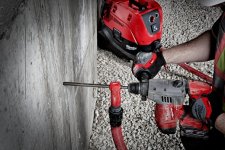(My first post here  I believe this is the appropriate board to post this; if not, move as necessary!)
I believe this is the appropriate board to post this; if not, move as necessary!)
Background
I have very little experience with any construction/renovation/etc, but I'm taking the time now to research all of this and come up to speed. I'm excited about finally being able to do simple things myself.
I'm going to be building a pre-fabricated backyard office, and I'm using this project as a justification to get a variety of tools which will be used for more project going forward (a deck, some fences, some minor home renovation, etc.) I get an enormous amount of enjoyment out of both using the right tool for the job, as well as using a high-quality tool. Thus Festool has sucked me right in
Drilling the Holes
I'm most anxious about attaching the structure to the concrete slab, and wanted to make sure I had both the right drill(s) and bit(s) to do things properly. I have a ~5" deep concrete slab that I'm going to be drilling 1/2" wide 3" deep holes into to install Simpson strong tie bolts (info). I take it the BHC 18 rotary hammer is the drill for the job here?
Bit-wise - I see some SDS-plus rotary hammer bits that should work (example from Amazon). If I'll be drilling ~30 holes, should I worry about the bit lasting till the end?
Since I'm not using epoxy, I don't believe I need to be super careful about getting 100% of dust out of the holes, or brushing anything - but would the "drilling dust nozzle" (500483) take out most of the dust? Note that there will be 3" of wood on top of the hole, so the actual total depth of the hole will be 6" (3" wood + 3" concrete). Would the dust nozzle meaningfully keep the hole clean, or should I be blowing compressed air down there, regardless?
If I...accidentally drill all the way through the slab somehow, anything I can do to patch things up? I will use the depth stop, but just want to be prepared in case things go south. If I somehow hit the rebar reinforcement and have to move the hole slightly, should I try to fill in the original cavity?
Driving the Bolts
For driving in the 1/2" Simpson strong tie titen bolt (has a 3/4" bolt head) - would the TID 18 be best due to the high torque? Does the PDC 18/4 shine here instead?
For the bit I see the 495133 3/8" centrotec socket adapter, and would look for a 3/4" socket to attach. How does that item differ from the 769064 adapter?
A lot of questions ;D Again, I hope they were Festool-specific enough to be reasonable for this board. Thanks in advance for any comments to help make sure I'm not too far off track!
Background
I have very little experience with any construction/renovation/etc, but I'm taking the time now to research all of this and come up to speed. I'm excited about finally being able to do simple things myself.
I'm going to be building a pre-fabricated backyard office, and I'm using this project as a justification to get a variety of tools which will be used for more project going forward (a deck, some fences, some minor home renovation, etc.) I get an enormous amount of enjoyment out of both using the right tool for the job, as well as using a high-quality tool. Thus Festool has sucked me right in
Drilling the Holes
I'm most anxious about attaching the structure to the concrete slab, and wanted to make sure I had both the right drill(s) and bit(s) to do things properly. I have a ~5" deep concrete slab that I'm going to be drilling 1/2" wide 3" deep holes into to install Simpson strong tie bolts (info). I take it the BHC 18 rotary hammer is the drill for the job here?
Bit-wise - I see some SDS-plus rotary hammer bits that should work (example from Amazon). If I'll be drilling ~30 holes, should I worry about the bit lasting till the end?
Since I'm not using epoxy, I don't believe I need to be super careful about getting 100% of dust out of the holes, or brushing anything - but would the "drilling dust nozzle" (500483) take out most of the dust? Note that there will be 3" of wood on top of the hole, so the actual total depth of the hole will be 6" (3" wood + 3" concrete). Would the dust nozzle meaningfully keep the hole clean, or should I be blowing compressed air down there, regardless?
If I...accidentally drill all the way through the slab somehow, anything I can do to patch things up? I will use the depth stop, but just want to be prepared in case things go south. If I somehow hit the rebar reinforcement and have to move the hole slightly, should I try to fill in the original cavity?
Driving the Bolts
For driving in the 1/2" Simpson strong tie titen bolt (has a 3/4" bolt head) - would the TID 18 be best due to the high torque? Does the PDC 18/4 shine here instead?
For the bit I see the 495133 3/8" centrotec socket adapter, and would look for a 3/4" socket to attach. How does that item differ from the 769064 adapter?
A lot of questions ;D Again, I hope they were Festool-specific enough to be reasonable for this board. Thanks in advance for any comments to help make sure I'm not too far off track!


